Financial Analysis Report: Evaluating Investment Options in Healthcare
VerifiedAdded on 2020/05/08
|10
|1394
|82
Report
AI Summary
This report presents a financial analysis of three distinct healthcare scenarios: ABC Hospital, Serenity Health Care, and Montgomery Home and Community-Based Services. The analysis for ABC Hospital evaluates two investment options using Net Present Value (NPV), Return on Investment (ROI), and Internal Rate of Return (IRR) to determine the most feasible choice. For Serenity Health Care, the report assesses the CEO's decision to acquire Hall by examining the organization's liquidity position through current and acid ratio calculations. Finally, the analysis of Montgomery Home and Community-Based Services includes a break-even volume calculation and a detailed financial projection, evaluating the payback period. The report highlights the importance of financial metrics in making sound investment and operational decisions within the healthcare sector, providing a comprehensive overview of financial planning and analysis techniques. The report also includes references to relevant academic literature and industry resources.
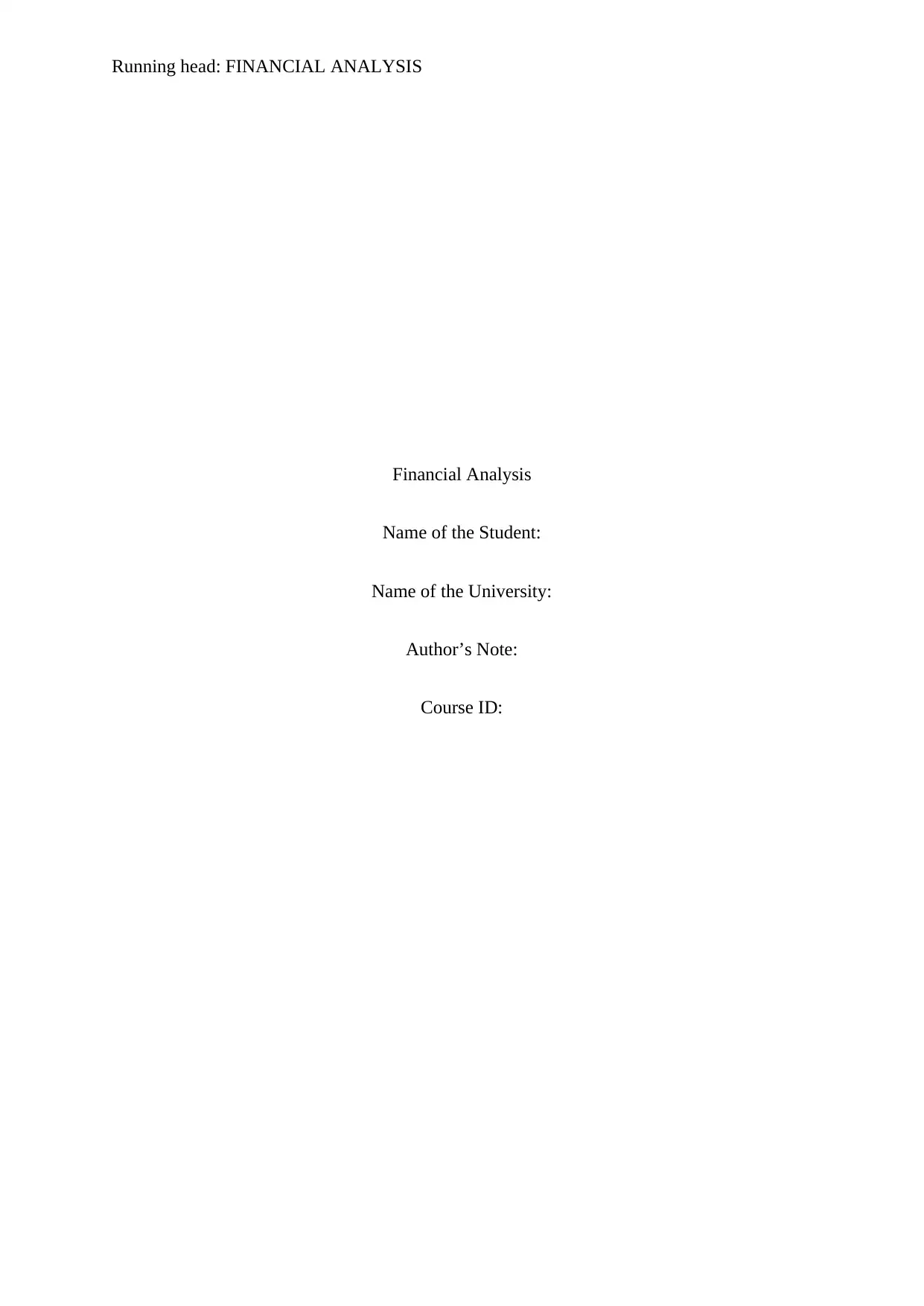
Running head: FINANCIAL ANALYSIS
Financial Analysis
Name of the Student:
Name of the University:
Author’s Note:
Course ID:
Financial Analysis
Name of the Student:
Name of the University:
Author’s Note:
Course ID:
Paraphrase This Document
Need a fresh take? Get an instant paraphrase of this document with our AI Paraphraser
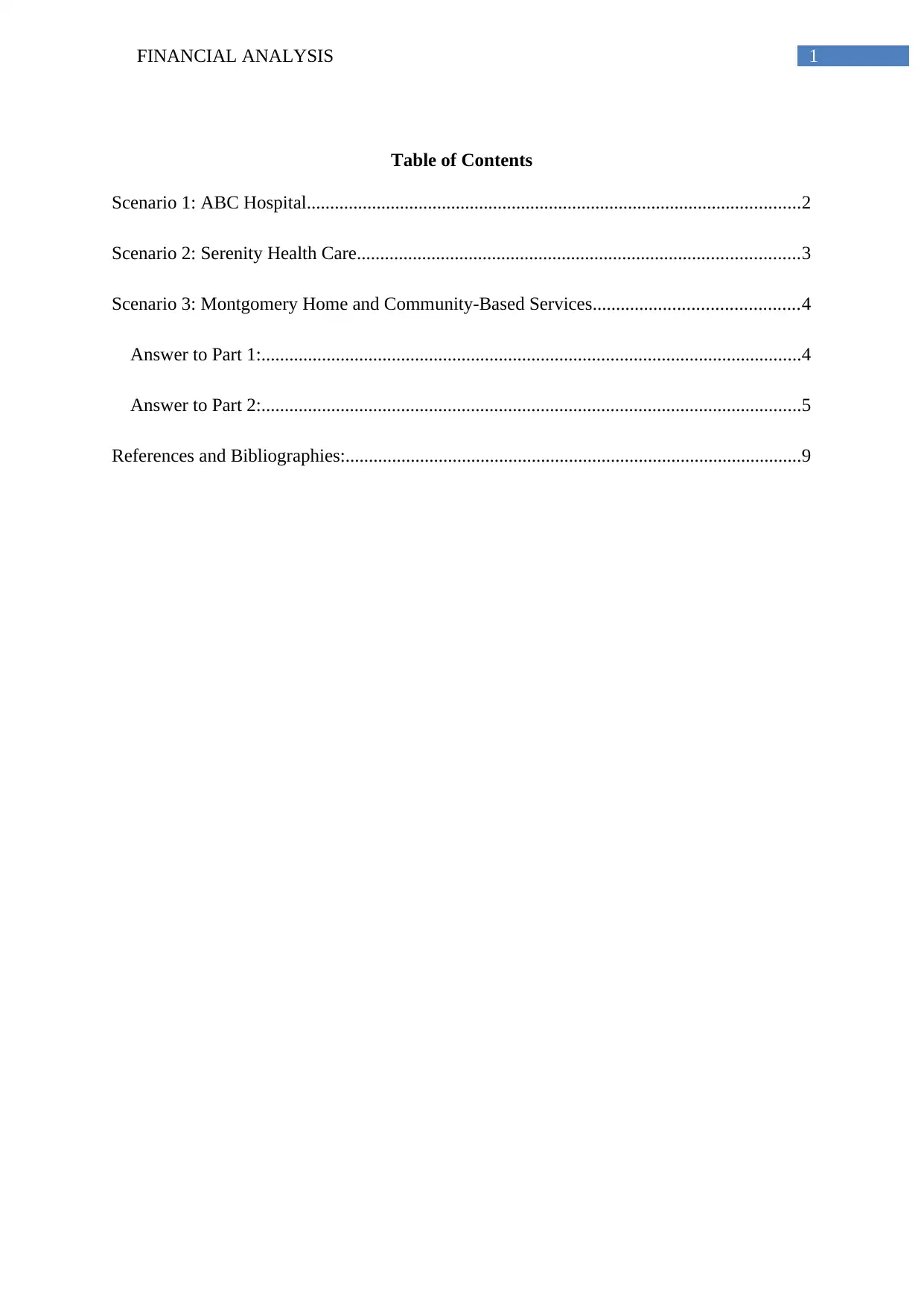
1FINANCIAL ANALYSIS
Table of Contents
Scenario 1: ABC Hospital..........................................................................................................2
Scenario 2: Serenity Health Care...............................................................................................3
Scenario 3: Montgomery Home and Community-Based Services............................................4
Answer to Part 1:....................................................................................................................4
Answer to Part 2:....................................................................................................................5
References and Bibliographies:..................................................................................................9
Table of Contents
Scenario 1: ABC Hospital..........................................................................................................2
Scenario 2: Serenity Health Care...............................................................................................3
Scenario 3: Montgomery Home and Community-Based Services............................................4
Answer to Part 1:....................................................................................................................4
Answer to Part 2:....................................................................................................................5
References and Bibliographies:..................................................................................................9

2FINANCIAL ANALYSIS
Scenario 1: ABC Hospital
Based on the provided scenario for ascertaining the feasibility of the two options, the
measures include net present value (NPV), return on investment (ROI) and internal rate of
return (IRR). The following calculation has been made in order to select the most feasible
option available to ABC Hospital:
Years
Cash inflows
for option 1
(in $)
Cash
inflows for
option 2
(in $)
Discounting
factor@8.9
%
Discounted
cash
inflows for
option 1 (in
$)
Discounted
cash inflows
for option 2
(in $)
0
-
1,19,95,000
-
50,95,000 1
-
1,19,95,000
-
50,95,000
1
20,00,00
0
15,00,00
0 0.92
18,36,54
7
13,77,41
0
2
40,00,00
0
30,00,00
0 0.84
33,72,90
6
25,29,67
9
3
50,00,00
0
45,00,00
0 0.77
38,71,56
3
34,84,40
7
4
80,00,00
0
65,00,00
0 0.71
56,88,24
7
46,21,70
1
4 (Interest payments) - - - -
-
28,02,250
Net Present Value (NPV) 27,74,26 41,15,94
Scenario 1: ABC Hospital
Based on the provided scenario for ascertaining the feasibility of the two options, the
measures include net present value (NPV), return on investment (ROI) and internal rate of
return (IRR). The following calculation has been made in order to select the most feasible
option available to ABC Hospital:
Years
Cash inflows
for option 1
(in $)
Cash
inflows for
option 2
(in $)
Discounting
factor@8.9
%
Discounted
cash
inflows for
option 1 (in
$)
Discounted
cash inflows
for option 2
(in $)
0
-
1,19,95,000
-
50,95,000 1
-
1,19,95,000
-
50,95,000
1
20,00,00
0
15,00,00
0 0.92
18,36,54
7
13,77,41
0
2
40,00,00
0
30,00,00
0 0.84
33,72,90
6
25,29,67
9
3
50,00,00
0
45,00,00
0 0.77
38,71,56
3
34,84,40
7
4
80,00,00
0
65,00,00
0 0.71
56,88,24
7
46,21,70
1
4 (Interest payments) - - - -
-
28,02,250
Net Present Value (NPV) 27,74,26 41,15,94
⊘ This is a preview!⊘
Do you want full access?
Subscribe today to unlock all pages.

Trusted by 1+ million students worldwide
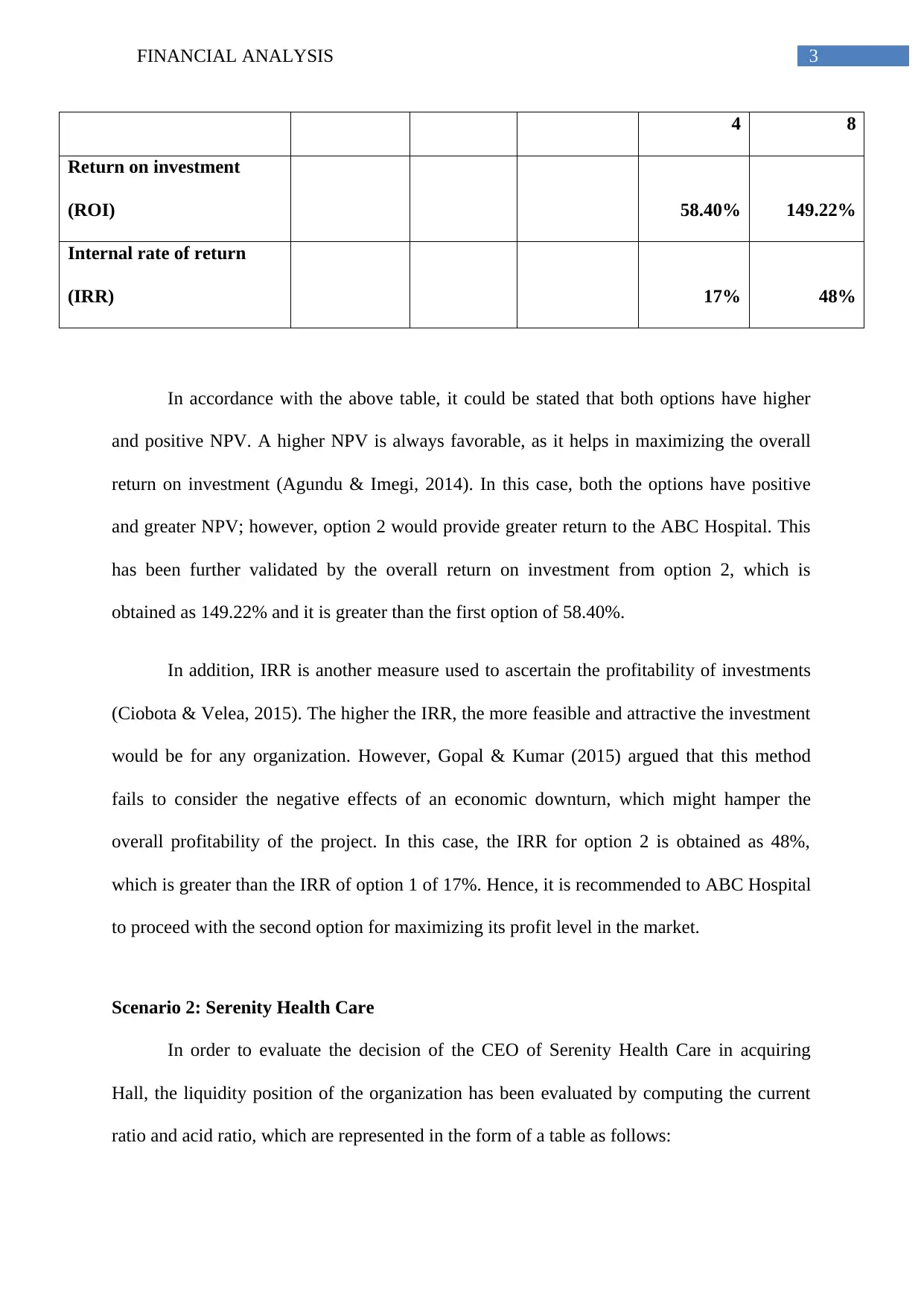
3FINANCIAL ANALYSIS
4 8
Return on investment
(ROI) 58.40% 149.22%
Internal rate of return
(IRR) 17% 48%
In accordance with the above table, it could be stated that both options have higher
and positive NPV. A higher NPV is always favorable, as it helps in maximizing the overall
return on investment (Agundu & Imegi, 2014). In this case, both the options have positive
and greater NPV; however, option 2 would provide greater return to the ABC Hospital. This
has been further validated by the overall return on investment from option 2, which is
obtained as 149.22% and it is greater than the first option of 58.40%.
In addition, IRR is another measure used to ascertain the profitability of investments
(Ciobota & Velea, 2015). The higher the IRR, the more feasible and attractive the investment
would be for any organization. However, Gopal & Kumar (2015) argued that this method
fails to consider the negative effects of an economic downturn, which might hamper the
overall profitability of the project. In this case, the IRR for option 2 is obtained as 48%,
which is greater than the IRR of option 1 of 17%. Hence, it is recommended to ABC Hospital
to proceed with the second option for maximizing its profit level in the market.
Scenario 2: Serenity Health Care
In order to evaluate the decision of the CEO of Serenity Health Care in acquiring
Hall, the liquidity position of the organization has been evaluated by computing the current
ratio and acid ratio, which are represented in the form of a table as follows:
4 8
Return on investment
(ROI) 58.40% 149.22%
Internal rate of return
(IRR) 17% 48%
In accordance with the above table, it could be stated that both options have higher
and positive NPV. A higher NPV is always favorable, as it helps in maximizing the overall
return on investment (Agundu & Imegi, 2014). In this case, both the options have positive
and greater NPV; however, option 2 would provide greater return to the ABC Hospital. This
has been further validated by the overall return on investment from option 2, which is
obtained as 149.22% and it is greater than the first option of 58.40%.
In addition, IRR is another measure used to ascertain the profitability of investments
(Ciobota & Velea, 2015). The higher the IRR, the more feasible and attractive the investment
would be for any organization. However, Gopal & Kumar (2015) argued that this method
fails to consider the negative effects of an economic downturn, which might hamper the
overall profitability of the project. In this case, the IRR for option 2 is obtained as 48%,
which is greater than the IRR of option 1 of 17%. Hence, it is recommended to ABC Hospital
to proceed with the second option for maximizing its profit level in the market.
Scenario 2: Serenity Health Care
In order to evaluate the decision of the CEO of Serenity Health Care in acquiring
Hall, the liquidity position of the organization has been evaluated by computing the current
ratio and acid ratio, which are represented in the form of a table as follows:
Paraphrase This Document
Need a fresh take? Get an instant paraphrase of this document with our AI Paraphraser
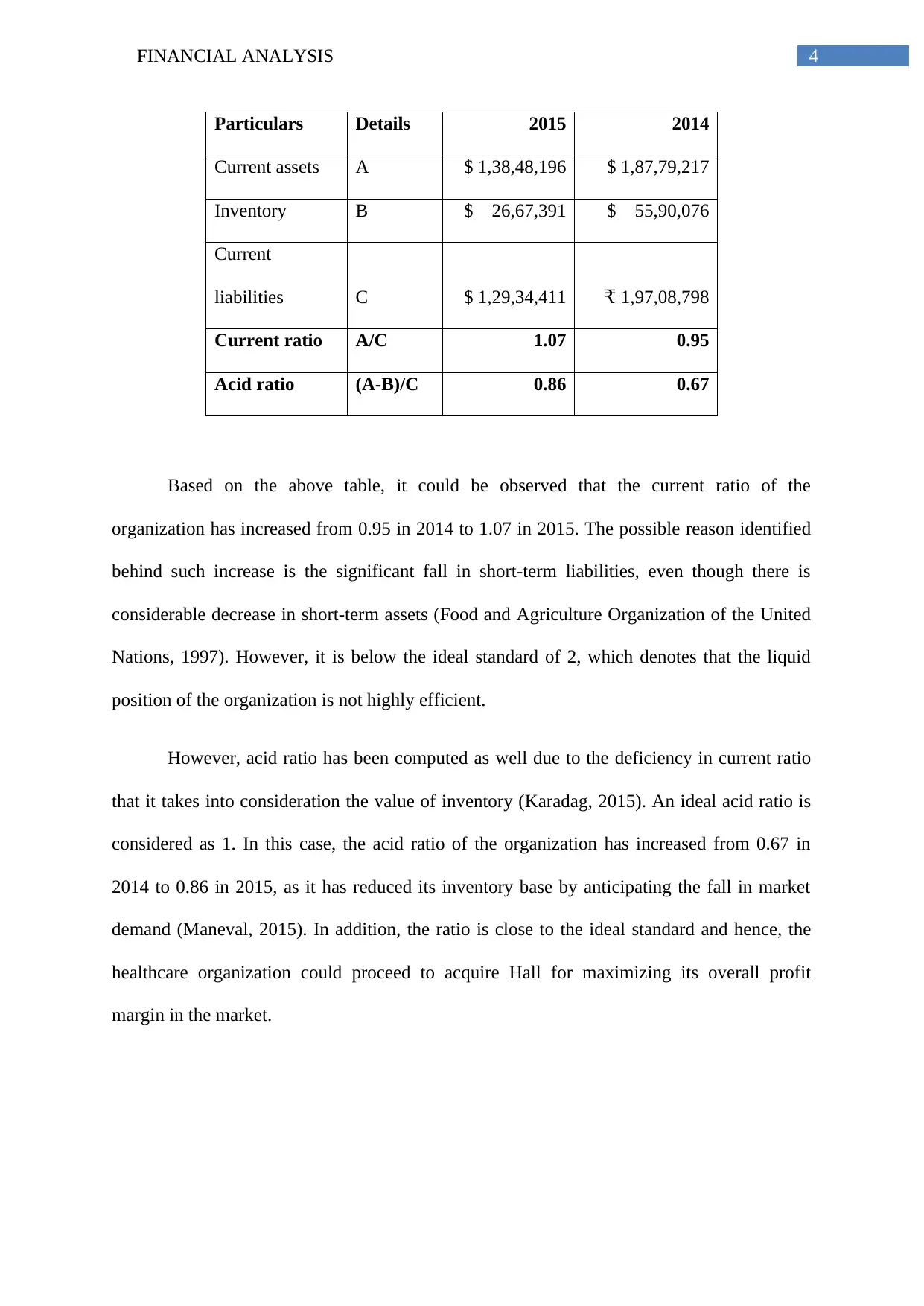
4FINANCIAL ANALYSIS
Particulars Details 2015 2014
Current assets A $ 1,38,48,196 $ 1,87,79,217
Inventory B $ 26,67,391 $ 55,90,076
Current
liabilities C $ 1,29,34,411 1,97,08,798₹
Current ratio A/C 1.07 0.95
Acid ratio (A-B)/C 0.86 0.67
Based on the above table, it could be observed that the current ratio of the
organization has increased from 0.95 in 2014 to 1.07 in 2015. The possible reason identified
behind such increase is the significant fall in short-term liabilities, even though there is
considerable decrease in short-term assets (Food and Agriculture Organization of the United
Nations, 1997). However, it is below the ideal standard of 2, which denotes that the liquid
position of the organization is not highly efficient.
However, acid ratio has been computed as well due to the deficiency in current ratio
that it takes into consideration the value of inventory (Karadag, 2015). An ideal acid ratio is
considered as 1. In this case, the acid ratio of the organization has increased from 0.67 in
2014 to 0.86 in 2015, as it has reduced its inventory base by anticipating the fall in market
demand (Maneval, 2015). In addition, the ratio is close to the ideal standard and hence, the
healthcare organization could proceed to acquire Hall for maximizing its overall profit
margin in the market.
Particulars Details 2015 2014
Current assets A $ 1,38,48,196 $ 1,87,79,217
Inventory B $ 26,67,391 $ 55,90,076
Current
liabilities C $ 1,29,34,411 1,97,08,798₹
Current ratio A/C 1.07 0.95
Acid ratio (A-B)/C 0.86 0.67
Based on the above table, it could be observed that the current ratio of the
organization has increased from 0.95 in 2014 to 1.07 in 2015. The possible reason identified
behind such increase is the significant fall in short-term liabilities, even though there is
considerable decrease in short-term assets (Food and Agriculture Organization of the United
Nations, 1997). However, it is below the ideal standard of 2, which denotes that the liquid
position of the organization is not highly efficient.
However, acid ratio has been computed as well due to the deficiency in current ratio
that it takes into consideration the value of inventory (Karadag, 2015). An ideal acid ratio is
considered as 1. In this case, the acid ratio of the organization has increased from 0.67 in
2014 to 0.86 in 2015, as it has reduced its inventory base by anticipating the fall in market
demand (Maneval, 2015). In addition, the ratio is close to the ideal standard and hence, the
healthcare organization could proceed to acquire Hall for maximizing its overall profit
margin in the market.
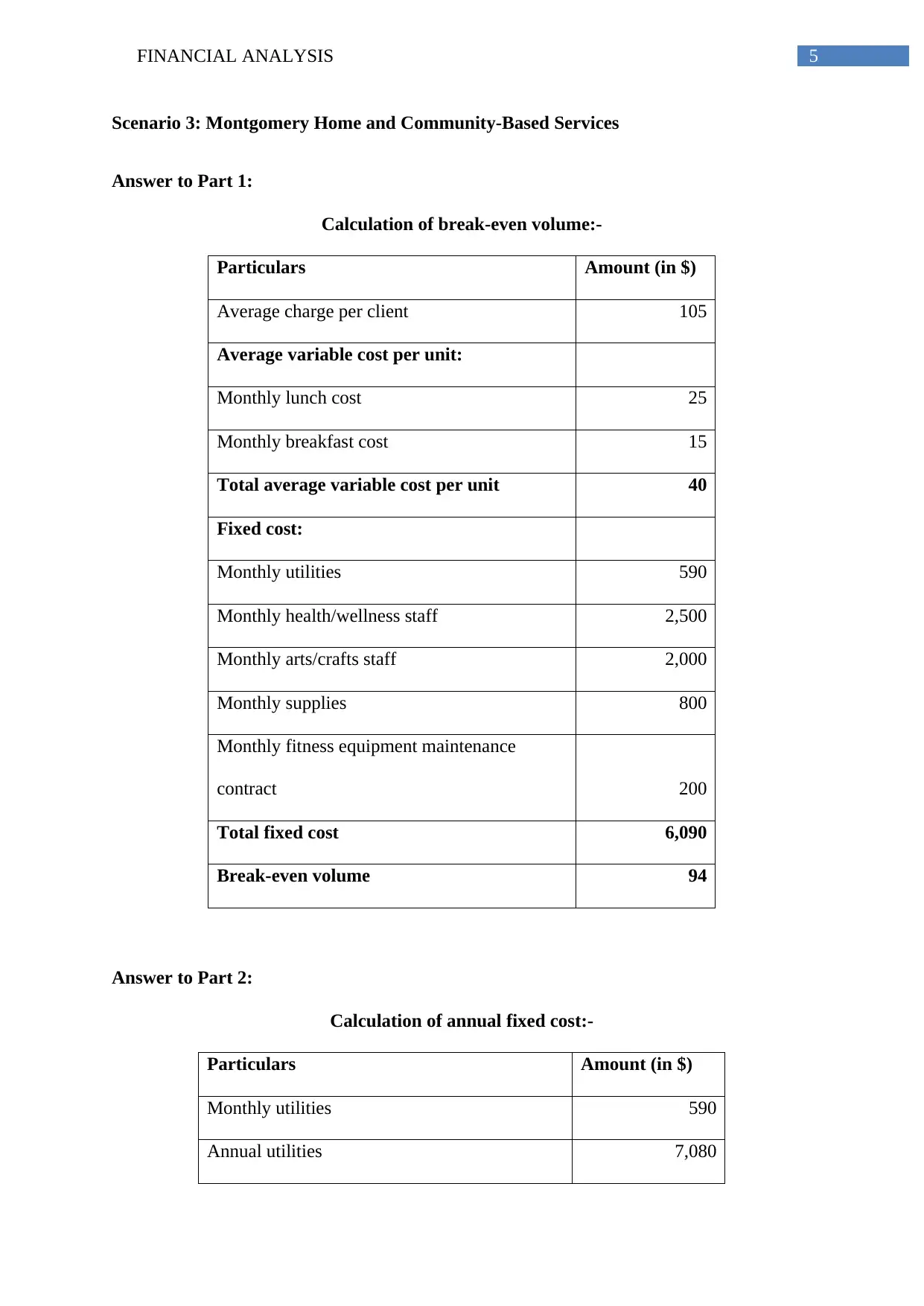
5FINANCIAL ANALYSIS
Scenario 3: Montgomery Home and Community-Based Services
Answer to Part 1:
Calculation of break-even volume:-
Particulars Amount (in $)
Average charge per client 105
Average variable cost per unit:
Monthly lunch cost 25
Monthly breakfast cost 15
Total average variable cost per unit 40
Fixed cost:
Monthly utilities 590
Monthly health/wellness staff 2,500
Monthly arts/crafts staff 2,000
Monthly supplies 800
Monthly fitness equipment maintenance
contract 200
Total fixed cost 6,090
Break-even volume 94
Answer to Part 2:
Calculation of annual fixed cost:-
Particulars Amount (in $)
Monthly utilities 590
Annual utilities 7,080
Scenario 3: Montgomery Home and Community-Based Services
Answer to Part 1:
Calculation of break-even volume:-
Particulars Amount (in $)
Average charge per client 105
Average variable cost per unit:
Monthly lunch cost 25
Monthly breakfast cost 15
Total average variable cost per unit 40
Fixed cost:
Monthly utilities 590
Monthly health/wellness staff 2,500
Monthly arts/crafts staff 2,000
Monthly supplies 800
Monthly fitness equipment maintenance
contract 200
Total fixed cost 6,090
Break-even volume 94
Answer to Part 2:
Calculation of annual fixed cost:-
Particulars Amount (in $)
Monthly utilities 590
Annual utilities 7,080
⊘ This is a preview!⊘
Do you want full access?
Subscribe today to unlock all pages.

Trusted by 1+ million students worldwide
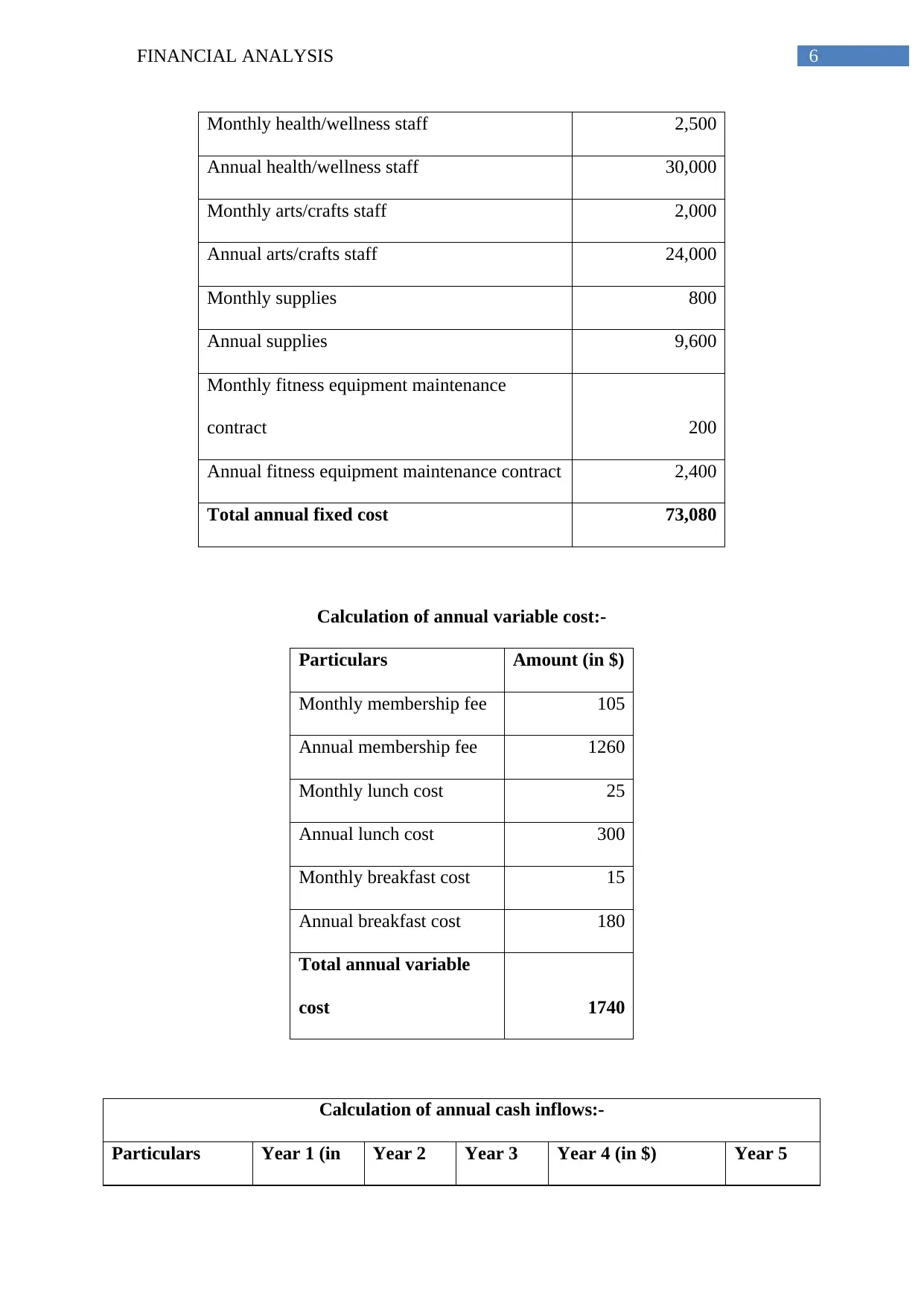
6FINANCIAL ANALYSIS
Monthly health/wellness staff 2,500
Annual health/wellness staff 30,000
Monthly arts/crafts staff 2,000
Annual arts/crafts staff 24,000
Monthly supplies 800
Annual supplies 9,600
Monthly fitness equipment maintenance
contract 200
Annual fitness equipment maintenance contract 2,400
Total annual fixed cost 73,080
Calculation of annual variable cost:-
Particulars Amount (in $)
Monthly membership fee 105
Annual membership fee 1260
Monthly lunch cost 25
Annual lunch cost 300
Monthly breakfast cost 15
Annual breakfast cost 180
Total annual variable
cost 1740
Calculation of annual cash inflows:-
Particulars Year 1 (in Year 2 Year 3 Year 4 (in $) Year 5
Monthly health/wellness staff 2,500
Annual health/wellness staff 30,000
Monthly arts/crafts staff 2,000
Annual arts/crafts staff 24,000
Monthly supplies 800
Annual supplies 9,600
Monthly fitness equipment maintenance
contract 200
Annual fitness equipment maintenance contract 2,400
Total annual fixed cost 73,080
Calculation of annual variable cost:-
Particulars Amount (in $)
Monthly membership fee 105
Annual membership fee 1260
Monthly lunch cost 25
Annual lunch cost 300
Monthly breakfast cost 15
Annual breakfast cost 180
Total annual variable
cost 1740
Calculation of annual cash inflows:-
Particulars Year 1 (in Year 2 Year 3 Year 4 (in $) Year 5
Paraphrase This Document
Need a fresh take? Get an instant paraphrase of this document with our AI Paraphraser
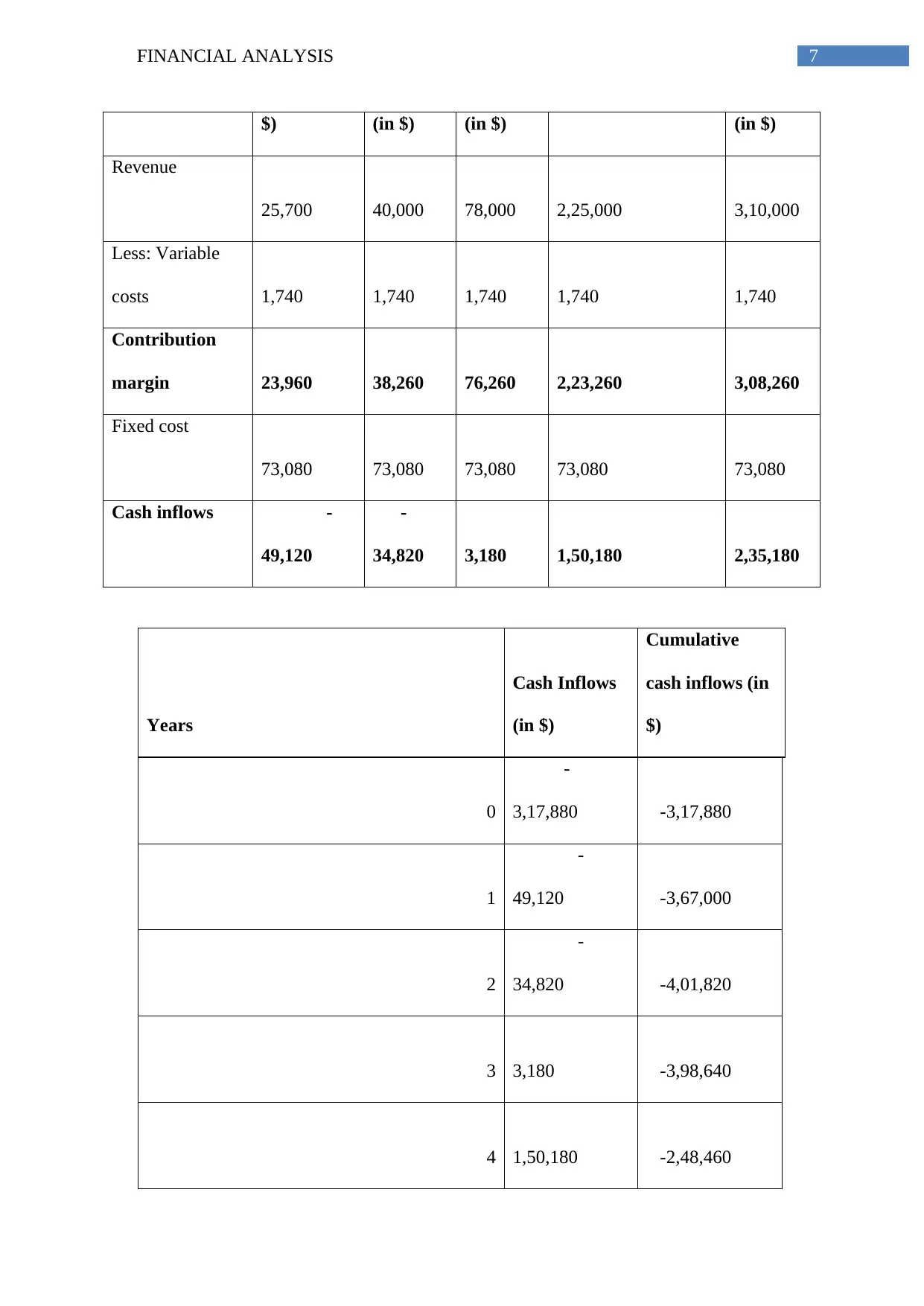
7FINANCIAL ANALYSIS
$) (in $) (in $) (in $)
Revenue
25,700 40,000 78,000 2,25,000 3,10,000
Less: Variable
costs 1,740 1,740 1,740 1,740 1,740
Contribution
margin 23,960 38,260 76,260 2,23,260 3,08,260
Fixed cost
73,080 73,080 73,080 73,080 73,080
Cash inflows -
49,120
-
34,820 3,180 1,50,180 2,35,180
Years
Cash Inflows
(in $)
Cumulative
cash inflows (in
$)
0
-
3,17,880 -3,17,880
1
-
49,120 -3,67,000
2
-
34,820 -4,01,820
3 3,180 -3,98,640
4 1,50,180 -2,48,460
$) (in $) (in $) (in $)
Revenue
25,700 40,000 78,000 2,25,000 3,10,000
Less: Variable
costs 1,740 1,740 1,740 1,740 1,740
Contribution
margin 23,960 38,260 76,260 2,23,260 3,08,260
Fixed cost
73,080 73,080 73,080 73,080 73,080
Cash inflows -
49,120
-
34,820 3,180 1,50,180 2,35,180
Years
Cash Inflows
(in $)
Cumulative
cash inflows (in
$)
0
-
3,17,880 -3,17,880
1
-
49,120 -3,67,000
2
-
34,820 -4,01,820
3 3,180 -3,98,640
4 1,50,180 -2,48,460
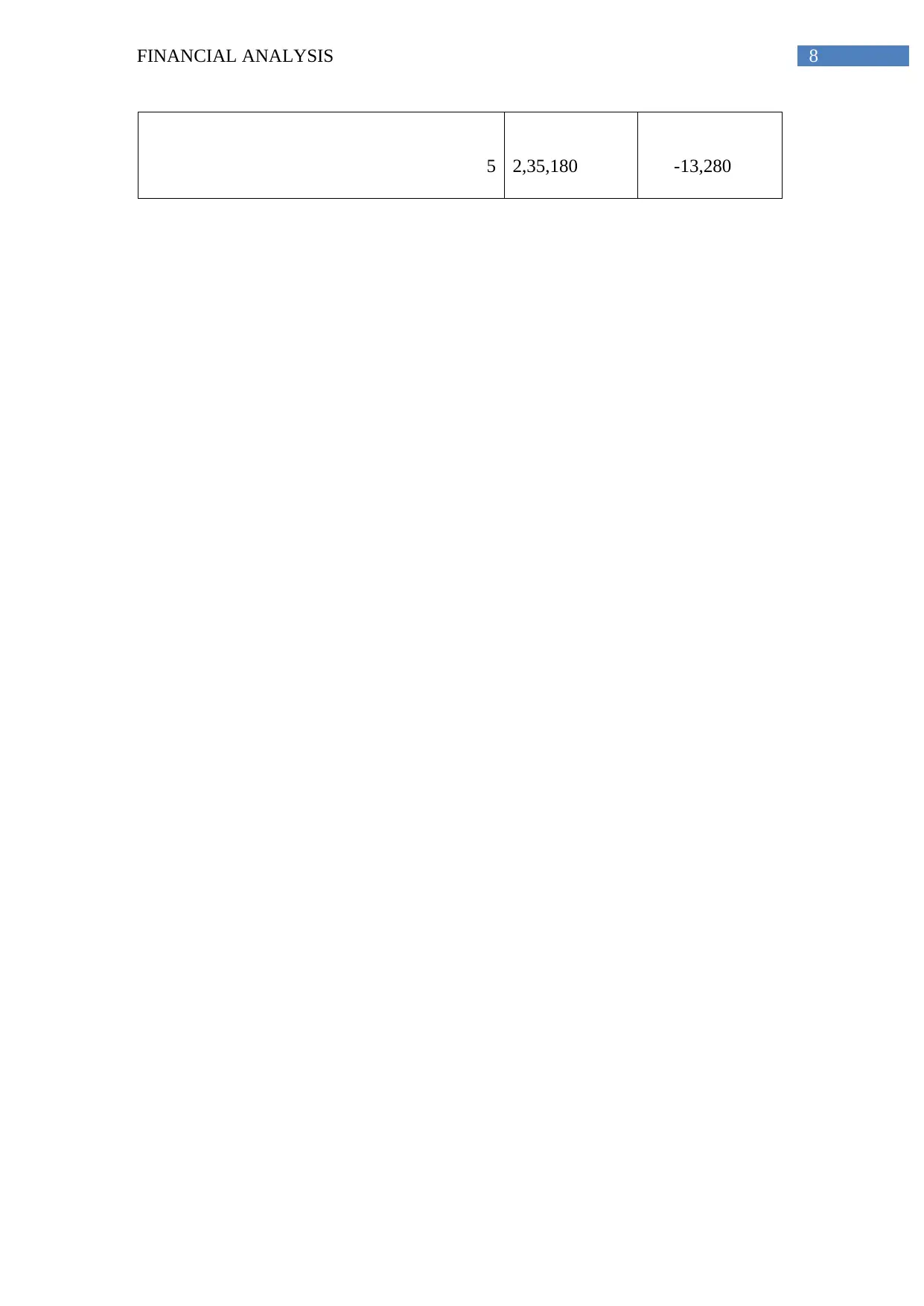
8FINANCIAL ANALYSIS
5 2,35,180 -13,280
5 2,35,180 -13,280
⊘ This is a preview!⊘
Do you want full access?
Subscribe today to unlock all pages.

Trusted by 1+ million students worldwide
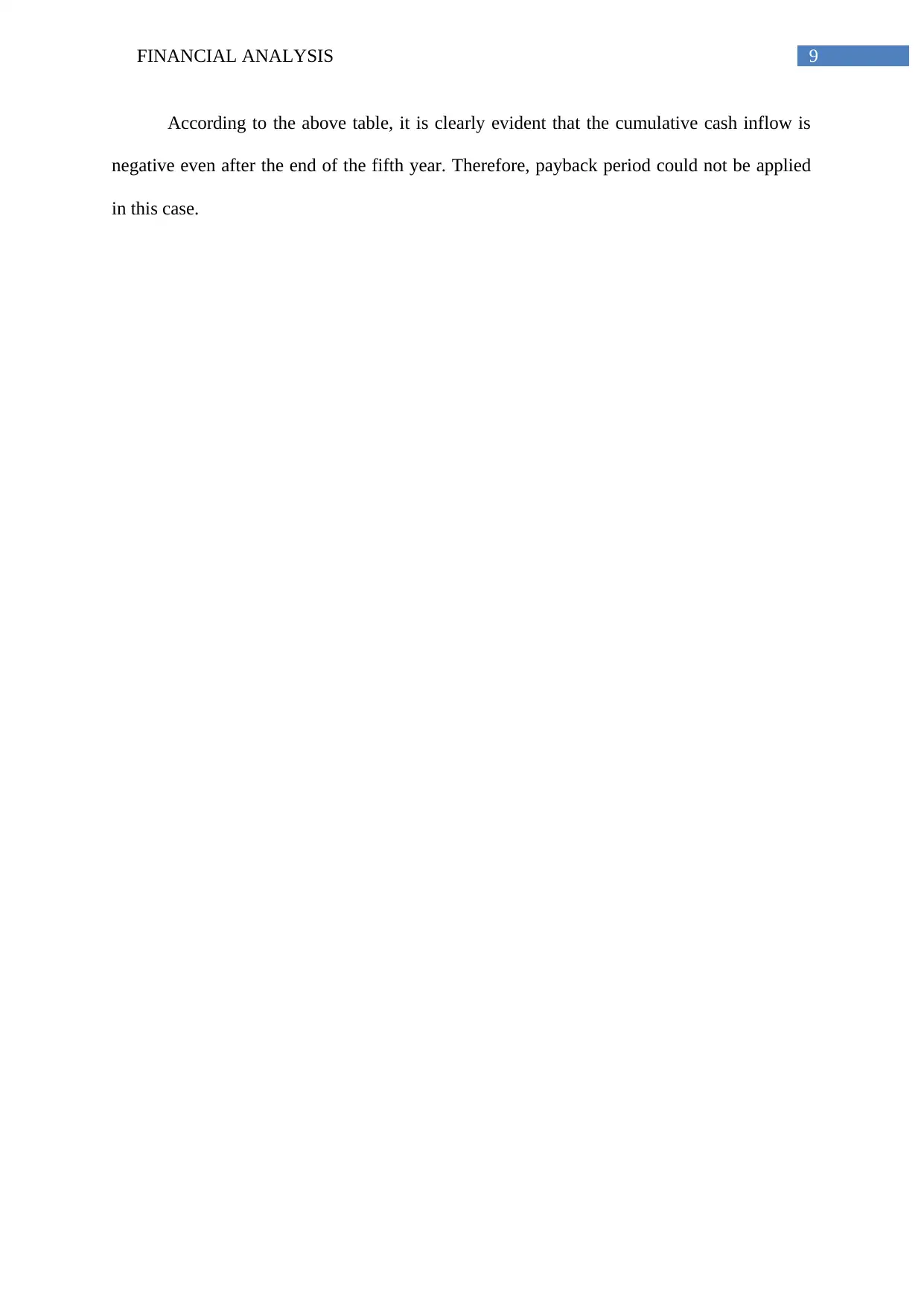
9FINANCIAL ANALYSIS
According to the above table, it is clearly evident that the cumulative cash inflow is
negative even after the end of the fifth year. Therefore, payback period could not be applied
in this case.
According to the above table, it is clearly evident that the cumulative cash inflow is
negative even after the end of the fifth year. Therefore, payback period could not be applied
in this case.
1 out of 10